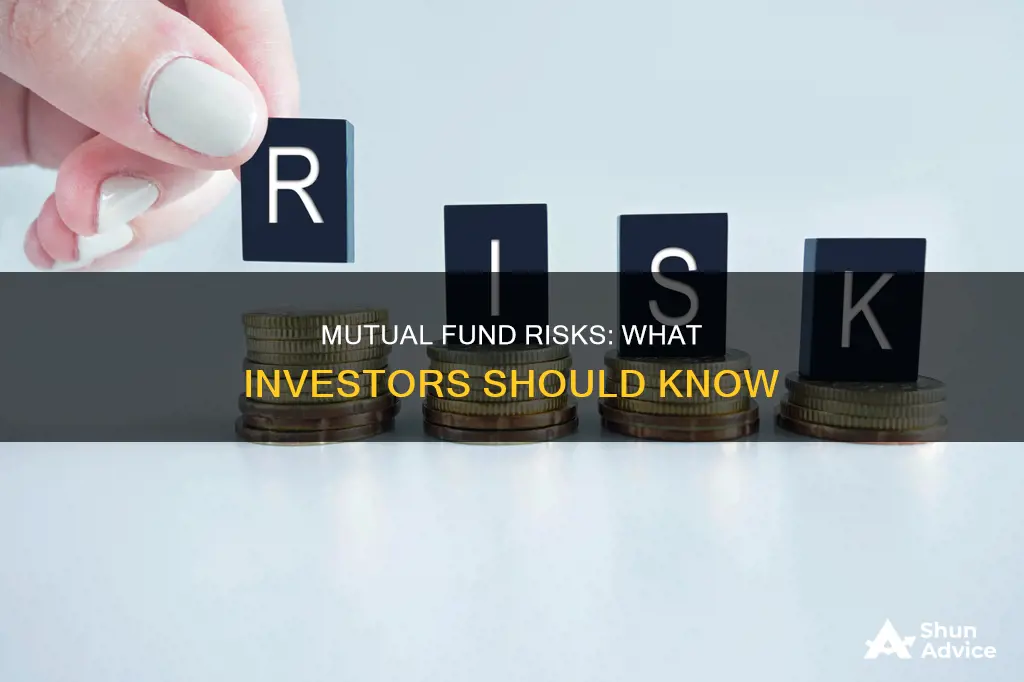
Investing in mutual funds is a popular choice, but it is not without its risks. While mutual funds are generally considered low-risk, they are not risk-free. The risks associated with investing in mutual funds can be broadly categorised into systematic risk and unsystematic risk. Systematic risks include changing market conditions, economic developments, government policies, interest rates, investor sentiment, and external shocks. Unsystematic risks include liquidity risk, inflation rate risk, credit risk, and interest rate risk. It's important for investors to understand these risks and make informed decisions that align with their individual circumstances, goals, and risk tolerance.
| Characteristics | Values |
|---|---|
| Risk type | Systematic risk and unsystematic risk |
| Security specific risk | Defaulting on coupon repayment, credit rating downgrade |
| Liquidity risk | Difficulty redeeming investments without loss |
| Inflation rate risk | Loss of purchasing power |
| Interest rate risk | Varying interest value |
| Credit risk | Not getting paid as promised |
| Exchange rate risk | Decrease in foreign currency |
| Market risk | Economic developments, government policies, regulatory changes, interest rates, investor sentiment, external shocks |
| Management risk | Abuse of authority, poor trade execution |
What You'll Learn

Risk of reduced Net Asset Value
The value of investments in mutual funds can fluctuate due to an increase or decrease in the net asset value (NAV) of the fund. This is influenced by changes in the price of securities and other associated risks. There is no guarantee that an investor's investment value will not decrease, nor is there any guarantee that it will increase.
The performance of a mutual fund is dependent on the ability of its investment manager. In exceptional circumstances, banks, securities issuers, or other parties related to the fund may default on their obligations, which will negatively affect the fund's performance.
Liquidity risk is also a factor. This is related to the ability of the investment manager to provide sufficient cash to pay for the redemption of participation units submitted by unit holders. If most unit holders submit a redemption application within a short period of time or simultaneously, there is a possibility that the redemption payment will be delayed. This is because the investment manager's ability to provide cash is also affected by the liquidity level of the securities that will be sold in the respective mutual fund to fulfill the redemption payment.
In the event of circumstances beyond the control of the investment manager (force majeure), the redemption may be temporarily suspended in accordance with the provisions in the collective investment contract and/or the Financial Services Authority (OJK) Regulation.
Unlocking Opportunity Fund Investments: A Guide to Success
You may want to see also

Risk of changes in political, economic and regulatory conditions
Changes in political, economic, and regulatory conditions can significantly impact the performance of a mutual fund. These changes can affect the performance of the issuer of debt securities and/or equities where the mutual fund invests. For example, a change in government directives, economic cycles, or regulatory frameworks can influence stock prices and either increase or decrease share values. Mutual funds with long-term and rigid lock-in periods, such as ELSS, often come with liquidity risk, making it challenging for investors to redeem their investments without incurring a loss.
Additionally, interest rate changes can affect the price of debt instruments. For instance, when interest rates increase, the price and value of bonds decrease. Credit risk arises when the issuer of the scheme fails to pay the promised interest, which can occur when fund managers include lower credit-rated securities to enhance returns.
Inflation also plays a crucial role in the risk of changes in economic conditions. Investors are exposed to inflation risk when the rate of returns on their investments fails to keep up with the inflation rate, resulting in reduced purchasing power.
Furthermore, external shocks such as natural disasters, wars, or other unforeseen events can impact the performance of mutual funds. These events can cause fluctuations in the market and affect the value of investments.
It is important for investors to carefully consider these risk factors and assess their risk tolerance before investing in mutual funds. Diversification and professional financial advice can help mitigate some of these risks.
Bond of America: State Investment Destinations
You may want to see also

Risk of fluctuation in exchange and interest rates
Fluctuations in exchange and interest rates can significantly impact the value of investments in mutual funds. This risk is particularly relevant for investors in Indonesia, where mutual funds may be affected by fluctuations in the exchange rate between the Indonesian Rupiah and foreign currencies, as well as interest rate fluctuations between Rupiah and non-Rupiah investments. These fluctuations ultimately impact the Net Asset Value (NAV) of the mutual fund.
The impact of fluctuating exchange rates is also known as currency risk. This risk is heightened for investments denominated in a currency other than the Canadian dollar. If the Canadian dollar declines against another currency, the investment's value will decrease.
Interest rate risk, on the other hand, affects the value of fixed-income securities. Typically, when interest rates rise, the value of fixed-income securities falls. This risk is especially pertinent if the loan obtained to finance mutual fund purchases has a variable borrowing cost, which can increase if interest rates rise.
Fluctuations in exchange and interest rates are just one type of risk associated with mutual funds. Other risks include market risk, liquidity risk, credit risk, and the risk of non-compliance. It is important for investors to understand these risks and adopt smart investment strategies to mitigate their impact.
Best Funds to Invest in: Where to Start?
You may want to see also

Risk of management abuses
Management abuses can take many forms, and it is a significant risk when investing in mutual funds. Mutual funds are a collection of investments from multiple investors, professionally managed by a fund manager. While the manager is expected to act in the investors' best interests, there are several ways in which they may abuse their authority.
One form of abuse is "churning", where the manager engages in unnecessary trading, potentially to generate more fees for themselves or the fund management company. This can increase costs for investors and may not always be in their best interests.
Another abuse of power is "window dressing". This occurs when fund managers sell underperforming assets before the quarter-end to improve the appearance of the fund's performance. This can be misleading to investors and distort the actual performance of the fund.
Excessive replacement of assets, or "turnover", is also a potential issue. High turnover can indicate that the manager is trying to improve short-term performance at the expense of long-term gains. It can also generate additional costs and have tax implications for investors.
The potential for management abuse is an inherent risk in mutual funds due to the level of control and discretion given to fund managers. Investors should be cautious and conduct thorough research before investing. Understanding the manager's track record, experience, and investment style can help mitigate this risk.
Mutual Funds: Risky Business and Why You Should Avoid
You may want to see also

Risk of high expense ratios and sales charges
One of the main disadvantages of investing in mutual funds is the risk of high expense ratios and sales charges. These fees can significantly eat into your overall investment returns, so it's important to be cautious and aware of the costs involved.
Expense ratios for mutual funds are considered high if they exceed 1.50%. This is the percentage of assets that will be used to cover the fund's operating expenses, including management fees, and it is an ongoing cost that investors pay for as long as they hold the fund. It's important to note that funds with higher expense ratios do not necessarily perform better than those with lower fees.
Sales charges, also known as 'loads', are commissions or fees paid to the broker or salesperson when you buy or sell shares in the fund. These charges can be front-end loads, which are paid when you buy the fund, or back-end loads, which are paid when you sell. Some funds may also charge 12b-1 fees, which are annual marketing or distribution fees. These fees are important to consider as they can add up over time and impact your overall returns.
It's worth noting that there are fund companies that offer no sales charges, and exchange-traded funds (ETFs) generally have lower costs than mutual funds. So, it's important to do your research and understand all the associated fees before investing in a mutual fund. By comparing the Fund Facts and simplified prospectus documents of different funds, you can gain a clear understanding of the costs involved and make a more informed decision.
While mutual funds offer benefits such as professional management and diversification, it's crucial to carefully consider the potential risks, including high expense ratios and sales charges, before investing.
A Guide to Mutual Fund Investing: Getting Started
You may want to see also
Frequently asked questions
There are several risks associated with investing in mutual funds. Firstly, there is market risk, where the value of investments may decline due to economic developments or other events affecting the wider market. Secondly, there is liquidity risk, which refers to the difficulty of selling an investment without incurring a loss. Thirdly, there is credit risk, where the fund may suffer losses if a bond issuer defaults on repayment. Other risks include interest rate risk, inflation risk, and currency risk. It's important to note that mutual funds are not guaranteed to provide income or capital appreciation, and investors could lose money if the value of the fund decreases.
The level of risk in a mutual fund depends on the types of investments it holds. For example, stocks or equity funds are generally riskier than bonds or fixed-income funds. Specialty funds that focus on emerging markets or other specific types of investments tend to carry a higher risk of a larger drop in value. Additionally, the fund's performance can be influenced by external factors such as political conditions, economic developments, regulatory changes, and interest rate movements.
To assess the risk of a mutual fund, you should consider the volatility of its returns over time. If the fund's returns vary significantly from year to year, it is likely a higher-risk investment. It is also important to evaluate how the fund fits within your investment portfolio and whether it aligns with your risk tolerance and financial goals. Consulting a financial advisor can help you make informed decisions about mutual fund investments.







